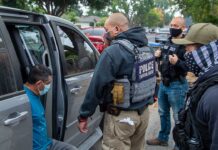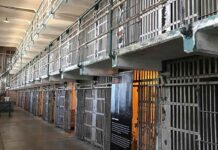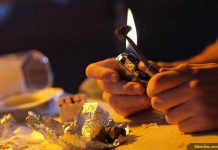In Northern California, the rains finally came and put out the raging fire, giving a well-needed rest to the firefighters who have been tirelessly battling the flames. In the burnt-out city of Paradise – a community which has been the focus of the entire nation for the past two weeks – the time has come to rebuild. Now the city is inundated with construction equipment, National Guard vehicles, and power company trucks. A reporter from Slavic Sacramento once again visited the disaster area, and this time measured the radiation in several places of a city that was reduced to ashes by the angry inferno.
Two weeks after the start of the record-setting fire, we headed back to Paradise to inspect the site of so much tragedy and grief, and also to take radiation measurements in different places in the area.
According to some sources, fires burning in the southern part of the state have affected – or even started in – the territory of the Santa Susana Field Laboratory, where NASA and Boeing, beginning in the late 1940s, conducted tests on nuclear reactors and rocket engines. Growing concerns about the danger prompted even Hollywood stars to appeal to the U.S. government, insistently demanding that congress conduct a thorough investigation.
Wildfires
In Northern California, and especially in Butte County, local authorities have spoken only about wildfires that engulfed 250 square kilometers for two entire weeks and ate up 18,000 buildings. To date, there are 85 confirmed dead as a result of the fire, some of whom were elderly people between 60 and 70 years of age. As soon as the fire reached the city limits, people rushed to their cars in an attempt to escape the disaster zone as soon as possible. Roads were quickly clogged with vehicles leaving Paradise. In a panic, many abandoned their cars on the road and fled on foot to try to outrun the flames. In some areas, I saw long lines of burnt-out cars right on the road. Everywhere I looked, it resembled a Hollywood summer blockbuster about the end of the world.
It’s worth mentioning that there are trees in the fire zone that were essentially unaffected by the fire. This is because the vast majority of trees that grow in Northern California are flame resistant. It’s quite common to see manzanita and cherry trees, cacti, and of course the virtually fireproof sequoia. Many homeowners, aware of these special characteristics, plant these types of trees and vegetation on their property. Additionally, some experts have stated that fast-moving grass fires mainly destroyed homes that were constructed from outdated, flammable materials. There were many wooden structures in the city, including houses, garages, and sheds. And in areas such as Butte County – far from the big city – most residents don’t think about installing or upgrading fire alarms and sprinkler systems.
On the other hand, it’s not difficult to see that the majority of trees were burned only on the side that faced a burning home, suggesting that the houses themselves were feeding the flames much more than the trees. Inside the houses, electricity and natural gas fueled the fire. This only confirms repeated claims that the power grid in California is both unsafe and sadly outdated, and more and more lawsuits against energy companies are being filed as a result.
Why Did So Many People Die?
Two factors combined to make the city of Paradise an extremely dangerous place to be in a fire: it is surrounded by forest, and the road system in and out of the community is not well-developed, consisting mainly of narrow byways. Three single-lane roads winding through the forest lead to the main thoroughfare, State Highway 99. In addition, in the past few years, the city has attempted to reinvent itself as a historic landmark from the Gold Rush era. In an effort to attract tourists, the city administration deliberately narrowed the roads in favor of sidewalks and pedestrian areas – which, according to some experts, played a tragic role during the evacuation.
Possible Contamination from Radiation?
After hearing reports from Butte County law enforcement about possible radiation in the affected area, I decided to visit Paradise again and try to detect signs of radioactivity. In order to take measurements, I used a portable detector called Smart Checker, made by the Korean company FT Lab. According to both experts and consumers, this miniature Geiger counter, which connects to an iPhone, can determine the level of radiation contamination with great accuracy.
I must say that after testing the soil in the area, including soil close to burned-down homes, as well as on the streets, I did not detect any radiation. The radiation level did not exceed 0.1 micro-sievert (µSv) per hour, which is the same background radiation observed in all major areas of Sacramento.
[rev_slider camp-fire-luda]
By way of comparison, a tomography session “charges” the human body with a dose of up to 10 µSv, and visit to the dentist’s office can be up to 0.01 µSv. The minimum amount that can cause cancer is 100 µSv, and exposure to 1,000 µSv can be fatal. According to the Centers for Disease Control and Prevention, an airline passenger traveling coast-to-coast across the U.S. absorbs about 0.035 µSv per hour. For comparison, a person standing next to the fourth reactor at the Chernobyl nuclear power plant will absorb from 0.9 to 200 µSv per hour; the latter dose can lead to death from radiation sickness.
When the atomic bombs were dropped on Japan during WWII, many survivors were exposed to radiation levels of 5 to 20 µSv. The most dangerous level of radiation ever recorded in Japan – 73 µSv – came after the Fukushima nuclear disaster.
It is likely that the rain – falling now for the second day in a row – has already washed away any traces of radiation. However, I tried my best to measure the levels in gutters and puddles. The result was the same – no radiation. Assuming that the reports from the Butte County authorities pertained to an industrial or commercial zone, I measured the background radiation at a burnt-out gas station in the center of Paradise. Again, the result was the same.
Returning from the “forbidden zone,” I calmly said goodbye to the National Guard soldiers. Despite the frequent natural disasters, California is still a wonderful state. And in spite of everything, in a year or two people will have rebuilt their homes, and life will go on as usual.



